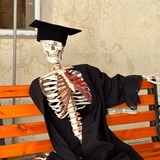Muscles of the Vocal cord
Tension: Cricothyroid
Relaxation: Throarytenoid
Adduction: lat. cricoarytenoid
Abduction: post. Cricoarytenoid
Nerve supply: Recurrent Laryngeal N.
Except Cricothyroid: External laryngeal N.
Tension: Cricothyroid
Relaxation: Throarytenoid
Adduction: lat. cricoarytenoid
Abduction: post. Cricoarytenoid
Nerve supply: Recurrent Laryngeal N.
Except Cricothyroid: External laryngeal N.
A patient presented with hoarsness of voice after thyroid surgery, what the most likely injured nerve?
Nerdy med students
Video
This is known as Vocal cord palsy Due to the injury of the recurrent laryngeal nerve
And not the external laryngeal nerve B.C it only innervates the cricothyroid muscle which is mainly responsible for controlling the pitch of the voice and the patient is presented with hoarseness of voice
And not the external laryngeal nerve B.C it only innervates the cricothyroid muscle which is mainly responsible for controlling the pitch of the voice and the patient is presented with hoarseness of voice
Neurons in the central NS are unable to regenerate
Because the damaged neurons are slow to clean up and because the oligodendrocytes (forming the CNS myelin sheath) inhibit the regeneration, therefore the environment is not optimal
However Neurons in the PNS are able to regenerate
Because these damaged neurons are easily cleaned up by macrophages, and The Schwann cells (forming the PNS myelin sheath) help in the repair
Therefore the PNS and CNS oppose each other on this matter
That’s why when we injure our fingers for example, the sensory nerves and it’s nociceptors regenerate
However an injury to part of the CNS leads to permanent damage.
Because the damaged neurons are slow to clean up and because the oligodendrocytes (forming the CNS myelin sheath) inhibit the regeneration, therefore the environment is not optimal
However Neurons in the PNS are able to regenerate
Because these damaged neurons are easily cleaned up by macrophages, and The Schwann cells (forming the PNS myelin sheath) help in the repair
Therefore the PNS and CNS oppose each other on this matter
That’s why when we injure our fingers for example, the sensory nerves and it’s nociceptors regenerate
However an injury to part of the CNS leads to permanent damage.
Although self-medication in non-human animals is often difficult to document, We observed a male Sumatran orangutan (a species of great ape) who sustained a facial wound. Three days after the injury he selectively ripped off leaves of a liana (that isn’t part of it’s diet) and chewed on them, and then repeatedly applied the resulting juice onto the facial wound. As a last step, he fully covered the wound with the chewed leaves. 8 days later the wound fully closed, one month later the wound fully healed, this related liana species are used in traditional medicine to treat various diseases, such as dysentery, diabetes, and malaria. Previous analyses of plant chemical compounds show the presence of furanoditerpenoids and protoberberine alkaloids, which are known to have antibacterial, anti-inflammatory, anti-fungal, antioxidant, and other biological activities of relevance to wound healing.
Nerdy med students
Although self-medication in non-human animals is often difficult to document, We observed a male Sumatran orangutan (a species of great ape) who sustained a facial wound. Three days after the injury he selectively ripped off leaves of a liana (that isn’t part…
In other words
القرود گامت تستخدم طب عرب
القرود گامت تستخدم طب عرب
